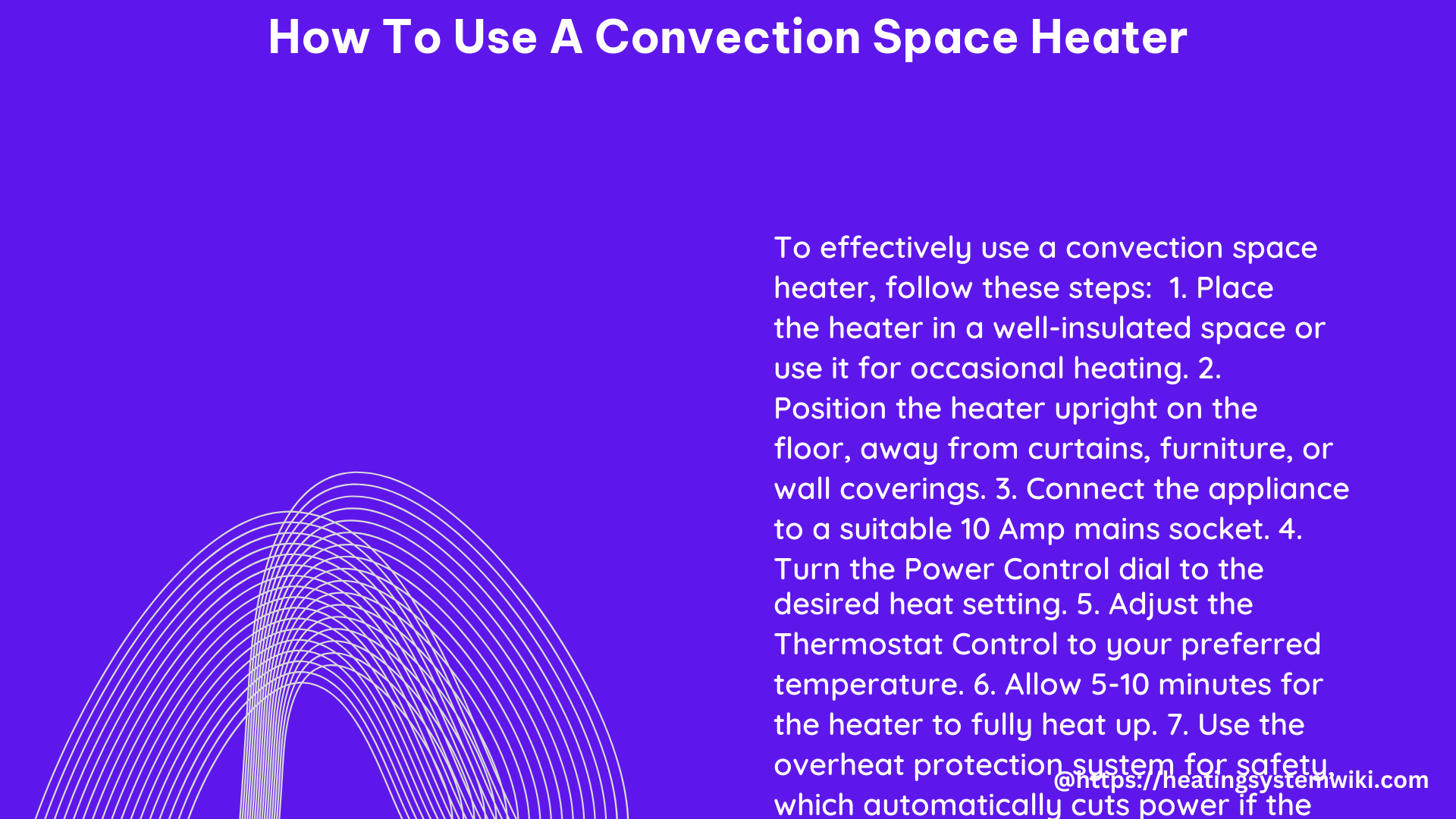A convection space heater is a versatile and efficient heating solution that can effectively warm up a room using natural air circulation. By understanding the intricacies of how these heaters work and the proper techniques for using them, you can maximize their performance and ensure a comfortable living environment. This comprehensive guide will delve into the details of operating a convection space heater, providing you with the knowledge and confidence to use this heating appliance effectively.
Understanding Convection Heating Principles
Convection space heaters operate on the principle of natural air circulation. They work by drawing in cool air from the lower part of the room, heating it using an internal heating element, and then releasing the warm air back into the room. This continuous cycle of warm air rising and cool air falling creates a gradual and even heating effect throughout the space.
The key components of a convection space heater include:
- Heating Element: This is the core component that generates the heat. Convection heaters typically use either a ceramic or infrared heating element, each with its own unique advantages.
- Air Intake Vents: Located at the bottom of the heater, these vents draw in the cool air from the room.
- Air Outlet Vents: Situated at the top of the heater, these vents release the heated air back into the room.
- Thermostat: This feature allows you to set and maintain the desired temperature in the room.
- Fan (Optional): Some convection heaters have a built-in fan that can be used to circulate the heated air more quickly, providing faster warming.
Preparing the Heater for Use

Before using your convection space heater, it’s essential to follow these steps to ensure safe and efficient operation:
- Placement: Choose a level, stable surface in the room you want to heat. Ensure there is ample clearance around the heater (at least 3 feet) to allow for proper airflow.
- Electrical Connection: Plug the heater into a suitable electrical outlet that can handle the power requirements. Avoid using extension cords, as they can pose a fire hazard.
- Inspection: Visually inspect the heater and its power cord for any signs of damage or wear. Do not use the heater if you notice any issues.
Operating the Convection Space Heater
Once the heater is properly positioned and connected, follow these steps to use it effectively:
- Power On: Locate the power switch or button on the heater and turn it to the “On” position.
- Temperature Adjustment: Set the desired temperature using the thermostat. Convection heaters typically have a temperature range of 40°F to 90°F (4°C to 32°C).
- Fan Setting (Optional): If your heater has a fan feature, you can choose to activate it to circulate the heated air more quickly, resulting in faster warming of the room.
- Monitoring: Keep an eye on the heater’s performance and adjust the thermostat as needed to maintain your desired temperature.
- Automatic Cycling: The heater will automatically cycle on and off to maintain the set temperature, conserving energy and ensuring consistent warmth.
Safety Considerations
Convection space heaters are generally safe when used properly, but it’s essential to follow these safety guidelines:
- Unattended Operation: Never leave the heater running unattended. Always turn it off and unplug it when not in use.
- Flammable Materials: Keep the heater at least 3 feet away from any flammable materials, such as curtains, furniture, or bedding.
- Damp Environments: Avoid using the heater in damp or humid environments, as this can damage the internal components.
- Cord Management: Do not use extension cords with the heater, as they can pose a fire hazard. Keep the power cord away from high-traffic areas to prevent tripping hazards.
- Tip-Over Protection: Many convection heaters have built-in tip-over switches that automatically shut off the power if the unit is knocked over, providing an additional safety feature.
Technical Specifications and Considerations
When selecting a convection space heater, it’s important to consider the following technical specifications:
| Specification | Typical Range |
|---|---|
| Power Consumption | 1,000 – 1,500 watts |
| Voltage | 120 volts |
| Frequency | 60 Hz |
| Cord Length | 4 – 6 feet |
| Thermostat Range | 40°F – 90°F (4°C – 32°C) |
| Weight | 10 – 15 pounds |
| Dimensions | 12 x 12 x 16 inches |
Additionally, some convection heaters may have advanced features, such as:
- Digital temperature display
- Programmable thermostat
- Remote control
- Oscillation for wider coverage
- Overheat protection
- Automatic shut-off
These features can enhance the user experience and provide additional safety and convenience.
Maintenance and Troubleshooting
To ensure the longevity and optimal performance of your convection space heater, it’s essential to perform regular maintenance and address any issues that may arise:
- Cleaning: Regularly clean the exterior and interior of the heater to remove dust and debris, which can impede airflow and reduce efficiency.
- Filter Replacement: If your heater has a removable air filter, replace it according to the manufacturer’s recommendations to maintain optimal air circulation.
- Thermostat Calibration: Periodically check the accuracy of the thermostat by comparing the displayed temperature to a reliable thermometer. Adjust the thermostat if necessary.
- Troubleshooting: If the heater is not functioning as expected, check for common issues such as a tripped circuit breaker, a faulty power cord, or a malfunctioning heating element or thermostat.
By following these maintenance and troubleshooting steps, you can keep your convection space heater running efficiently and safely for years to come.
Conclusion
Convection space heaters offer a versatile and energy-efficient heating solution for your home or office. By understanding the principles of convection heating, properly setting up and operating the heater, and adhering to safety guidelines, you can maximize the performance and benefits of this heating appliance. Remember to always prioritize safety, follow the manufacturer’s instructions, and perform regular maintenance to ensure a comfortable and worry-free heating experience.
